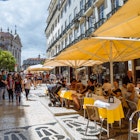
Feb 20, 2023 • 4 min read

Jun 28, 2024 • 5 min read

Explore Portugal's Douro Valley on a scenic day trip by train with these top tips © Armando Oliveira / Getty Images
Many consider the Linha do Douro, the train line that follows the valley, one of the most beautiful train rides in Europe.
The quaint Linha do Douro line in northern Portugal weaves through a river valley lined with vineyards.
There isn’t much in the tiny town of Pocinho. But in the case of northern Portugal’s Linha do Douro, the train line that connects this rural village and Porto, it’s more about the journey to get there.
The Douro River bisects the top half of Portugal, carving a ragged gap from east to west. That glass of port you tasted in Porto? It got its start in the almost impossibly steep vineyards that frame the river valley. And while most visitors to Porto will experience the Douro River via a cruise, I wanted to do it by train.
At around 200km (125 miles) long, the line terminates at Pocinho, just shy of the Spanish border. This means that the train doesn’t really get you anywhere in particular, and you have to return the way you came. But if done right, it’s possible to approach the Linha do Douro as a slow and contemplative – yet also occasionally dramatic – day trip, one that even offers a break for lunch and wine tasting.

To ensure that you have time for lunch or (and?) wine tasting, it’s necessary to take the first train of the day, which departs from Porto’s legendary São Bento Station at 7:15am. I was obliged to change trains in the town of Ermesinde, just northeast of Porto, and it was here that I boarded my Linha do Douro train (to avoid having to change trains, catch the first direct Linha do Douro service from São Bento at 8:20am). The stock – made in Switzerland, painted a ’70s-era orange and virtually empty – could easily have featured in a Wes Anderson film.
The next hour, you’ll traverse Porto’s urban sprawl – predominantly gray, semi-industrial feeling suburbs. Your first tunnel (of 23 total) is in Caíde, which is also where the views start to become more rural. The town of Ribadouro offers your first glimpse of the Douro, and it’s from this point on that things get interesting.

The train snakes along the river, with incredibly steep terraced vineyards and tiny villages clinging to hillsides rising on either side. I did the trip in late January when mist and fog obscured the views but created an otherworldly, remote atmosphere. Whistle-stop stations boast charming tiles; at some points the train tracks are virtually at river level. Be sure to sit on the right-hand side for the best views. You may be tempted to hop off in the large-ish city of Peso da Régua, but a wiser stop is Pinhão, where you’ll arrive at about 10am (nearer 11am, if you went direct from São Bento).

The terminus for one-day boat trips from Porto, Pinhão is a funny little town, a mix of crusty old winemakers and wide-eyed tourists. It also offers enough to occupy you for a few hours. Take the obligatory photo of the tile murals at the station, and after a walk along the charming waterfront, start planning lunch. A handful of cafes and restaurants are in the center of town, with spectacular riverfront eateries, such as Veladoura or Cozinha da Clara, located a short walk away.

Alternatively, Pinhão is also home to a legendary butcher, Talho Qualifer – Quinta das Barrocas, where you can taste smoked meats in-house or assemble a riverside picnic lunch. Of course, you’re in the heart of Portugal’s most prestigious wine country, so pencil in time for a tasting session. Several houses, including Croft, Quinta do Bomfim and Quinta do Noval are located right in town, and offer tastings of standard and fortified wines.
Satiated and slightly buzzed after four or five hours in Pinhão, it’s time to continue to the end of the line: Pocinho. Catch the 3:43pm, which arrives in Pocinho in time for you to catch the last return train back to Porto.

The final hour that connects Pinhão and Pocinho is arguably the most beautiful section of the line – and the section that the day-trippers on boats from Porto miss out on. Outside of Pinhão, the Douro narrows and the scenery becomes more rocky, rugged and wild. At Ferradosa, the train crosses a bridge (one of 35 along the route) to the south bank of the river. Shift to the left side of the train to see tiny train stations – shelters, really – that link to trailheads, abandoned wineries and vineyards that extend right to the tracks.
As you approach the end of the line, the landscape abruptly widens into a broad valley studded with olive trees, a dam and power plant ominously looming in the distance. In Pocinho, the original wooden station is still intact, though there’s not much else to see or do here.
Stretch your legs, take a bathroom break and board the train (most likely the same one you arrived on) returning to Porto, which departs at 5:14pm. If there are no delays, you should arrive in Porto around 8:30pm, just in time for dinner.

I did the trip in January, which meant the weather was particularly wet and misty. If you’re serious about clear views or photography – or simply want to take advantage of the longer daylight hours – make the trip during the summer months.
Pinhão is your best bet for food and drink. Alternatively, if you’re on a budget, pack a lunch and a bottle of wine ahead of time and plan a riverside picnic.
I bought my tickets in advance, yet given how few people ride the Linha do Douro nowadays, you’d probably be fine buying your tickets on the day of travel at the station.
A round-trip ticket costs just under €30; breaking the trip into bits and buying three separate tickets as I suggest here will cost a tiny bit more.


Feb 20, 2023 • 4 min read


Dec 1, 2022 • 7 min read


Nov 19, 2024 • 4 min read



